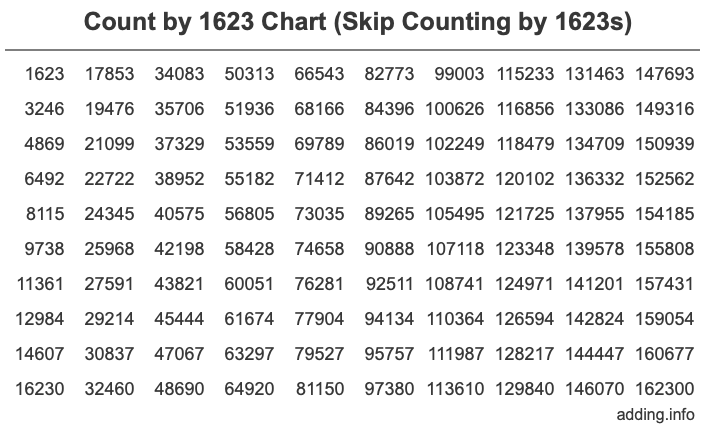Here we will show you how to count by 1623, discuss counting by 1623 patterns, and tell you why knowing how to count by 1623 matters. To start off, note that Count by 1623 means counting in 1623s, or count by one thousand six hundred twenty-threes, and it is also called skip counting by 1623.
How to count by 1623
Normally, we would count by 1 like this: 1, 2, 3, 4, etc., but when we count by 1623, we count 1623, 3246, 4869, 6492, and so on.
In other words, to count in intervals of 1623 or skip counting by 1623, we start with 1623 and then add 1623 to get the next number, and then continue adding 1623 to the previous number to keep counting by 1623, like this:
1623
1623 + 1623 = 3246
3246 + 1623 = 4869
4869 + 1623 = 6492
6492 + 1623 = 8115
...
You can of course skip count by 1623 forever, so it is impossible to make a list of all numbers, but below is a Count by 1623 Chart of the first 100 numbers to get you started.

Looking at the chart above, you will see that the first column has the first ten numbers you get when you skip count by 1623, the second column has the next ten numbers you get when you skip count by 1623, and so forth.
Count by 1623 Patterns
We organized the Skip Counting by 1623s Chart above in 10 rows and 10 columns so you can easily identify patterns.
Skip counting always creates patterns. Figuring out these patterns may help you if want to count by 1623, but don't have the Counting by 1623s Chart above. Obviously, one pattern with counting by 1623s is that the number increases by 1623.
Furthermore, if you look at each row above, each number in the row has the same last digit (ones place). That means that every tenth number has the same last digit.
If you look down the columns, you will see that the last digit (ones place) repeats itself in blocks of 10 over and over. The pattern of the last digit when you count by 1623 goes 3, 6, 9, 2, 5, 8, 1, 4, 7, 0 and 3, 6, 9, 2, 5, 8, 1, 4, 7, 0 and so on for as long as you count by 1623.
Why Count by 1623?
We think that understanding and learning about skip counting by 1623 is important, because it teaches you how the arithmetic operations fit together. Below are some examples of what we mean.
When you count by one thousand six hundred twenty-three, you are also creating a list of multiples of 1623 that you can use in math when you need the least common multiple. 1623 times n equals the nth multiple or skip count of 1623.
When you skip count by 1623, you are also creating a list of numbers that 1623 is divisible by. On top of that, skip counting by 1623 is the same as making the 1623 times table.
Skip Counting
Need to skip count by another number? Enter another number for us to skip count for you.
Count by 1624
Here is the next number on our list that we used to skip count.
Copyright | Privacy Policy | Disclaimer | Contact
